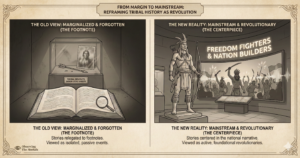Scattered across India, in monasteries, libraries, and private homes, lies a staggering intellectual treasure: millions of ancient and medieval manuscripts. These texts, on everything from astronomy and medicine to philosophy and statecraft, form one of the world’s richest and most diverse literary heritages. The Government of India’s new, ambitious Gyan Bharatam mission is a 21st-century endeavor to find, preserve, and digitize this vast, fragmented knowledge. This case study explores this monumental project, analyzing it not just as an act of cultural preservation, but as a powerful exercise in defining, curating, and “reclaiming” India’s knowledge legacy for the modern world.
The Information Box
Syllabus Connection:
- Paper 2: Chapter 1.1 (Indian Civilization), Chapter 1.1 (Contribution of Tribal Culture), Chapter 3 (Religion & Society)
- Paper 1: Chapter 9 (Applied Anthropology), Chapter 4 (Political Anthropology: Nationalism), Chapter 1.7 (Anthropology of Knowledge)
Key Concepts/Tags:
- Gyan Bharatam, Manuscriptology, Cultural Heritage, Politics of Knowledge, Applied Anthropology, Indian Knowledge Systems (IKS)
The Setting: Who, What, Where?
The setting is contemporary India, with the Ministry of Culture launching the Gyan Bharatam mission. The initiative is being highlighted by a major international conference in New Delhi titled “Reclaiming India’s Knowledge Legacy Through Manuscript Heritage.” The timing of this conference is symbolically linked to the anniversary of Swami Vivekananda’s 1893 Chicago address, explicitly framing the mission as part of a long tradition of asserting India’s intellectual heritage on the global stage. The subject matter is India’s immense and diverse corpus of manuscripts, with a stated goal to document, conserve, and digitize them on an unprecedented scale.
The Core Argument: Why This Study Matters
This mission is more than a simple archival project; it is a profound exercise in applied anthropology and the construction of a national narrative.
- Creating a National “Canon”: The core goal is to take a vast, decentralized, and diverse body of knowledge, much of it in regional languages and scripts, and bring it into a single, state-managed digital ecosystem. This act of collection, curation, and digitization is also an act of creating a national “canon”—a process of defining what constitutes the most important and representative texts of the “Indian Knowledge Legacy.”
- Applied Anthropology at Scale: This is a massive project in applied anthropology and archaeology. It involves highly specialized work like deciphering ancient scripts (including the ambitious goal of the Indus script), using advanced technology like AI and Handwritten Text Recognition (HTR) for documentation, and applying scientific conservation techniques. It is a clear example of using the tools of social science and humanities for a large-scale national objective.
- Knowledge as Cultural Diplomacy: The mission explicitly frames manuscripts as a tool of cultural diplomacy. By digitizing, translating, and forming partnerships with other nations, India is leveraging its ancient intellectual heritage as a form of “soft power.” This is an attempt to project its civilizational influence and historical significance on the global stage.
- The Politics of “Reclaiming”: The very language of the mission—”Reclaiming India’s Knowledge Legacy”—is politically significant. The word “reclaiming” implies that this knowledge was previously lost, neglected, or suppressed, and that the modern state is now acting as its rightful rescuer and promoter. This constructs a powerful political narrative of national revival.
The Anthropologist’s Gaze: A Critical Perspective
- Whose Knowledge, Which Canon?: A critical anthropological question is: in the process of creating a national canon from millions of texts, whose knowledge gets prioritized? Will the “Great Traditions” of Sanskritic, philosophical, and courtly texts be given more prominence than the “Little Traditions”—the folk knowledge, oral histories, and texts of marginalized or tribal communities recorded in regional scripts? The process of selection is an act of power that can elevate certain histories while downplaying others.
- Access vs. Control: While digitization promises to democratize access to knowledge, a centralized, state-controlled digital archive also creates a new and powerful form of gatekeeping. An anthropologist would ask: who will control this digital archive? Who will determine the terms of access and the official interpretations of the texts? Will it be an open platform for critical scholarship, or will it promote a single, state-approved narrative?
- The Risk of Decontextualization: An anthropological perspective values context. Removing a manuscript from its “social life”—its physical location in a monastery, its role in a specific ritual, its history of being handled by a particular family—and turning it into a digital file can strip it of its meaning as a cultural object. The digital text is preserved, but its social and ritual context can be lost.
- The Politicization of Decipherment: The mission’s inclusion of deciphering the Indus script is highly ambitious and politically charged. The undeciphered script is one of the most contentious topics in South Asian archaeology, with various theories linked to different political and linguistic identity claims. A state-led mission focusing on it could be perceived as an attempt to push a particular interpretation that aligns with a specific nationalistic narrative.
The Exam Angle: How to Use This in Your Mains Answer
- Types of Questions Where It can be Used:
- “Discuss the salient features of Indian civilization and the role of its textual traditions.”
- “What is the role of applied anthropology in cultural heritage management?”
- GS-1/Essay: “In the 21st century, cultural heritage has become an important instrument of national identity and ‘soft power.’ Discuss.”
- Model Integration:
- On Indian Civilization (Paper 2): “The continuity and diversity of Indian civilization are deeply rooted in its vast textual traditions. The government’s ‘Gyan Bharatam’ mission is a significant contemporary effort to preserve and digitize this manuscript heritage, using modern technology to centralize and promote what it defines as India’s ‘knowledge legacy’.”
- On Applied Anthropology (Paper 1): “Applied anthropology plays a key role in cultural heritage management. The ‘Gyan Bharatam’ mission is a massive-scale example, employing techniques from linguistics (script decipherment), archaeology (palaeography), and museum studies (conservation and digital archiving) for a major national project.”
- For a GS-1/Essay Answer: “In the 21st century, ‘soft power’ is a key aspect of international relations. India’s ‘Gyan Bharatam’ mission, aimed at digitizing millions of ancient manuscripts and promoting ‘Indian Knowledge Systems,’ is a clear example of using a rich historical and cultural heritage not just for preservation, but also for cultural diplomacy and the construction of a modern national narrative.”
Observer’s Take
The Gyan Bharatam mission is a monumental and deeply important undertaking. The effort to save and make accessible a vast and perishable intellectual heritage is a profoundly noble goal. However, it is also a powerful act of modern statecraft. The process of “reclaiming” a knowledge legacy is also a process of defining it. The great challenge for this mission will be to balance the nationalistic goal of creating a unified story of India’s intellectual glory with the scholarly responsibility to represent the immense diversity, and sometimes the inherent contradictions, within that legacy. It is a project not just about preserving the texts of the past, but about writing the story that the future will inherit.





